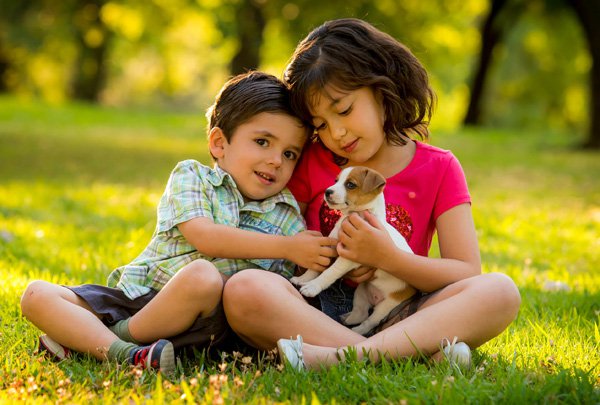
Although our dogs cannot speak with us by way of words, they can still offer us a powerful range of signs and signals to tell us how they are feeling. Dogs learn this body language at an young age in order that they can transmit a message that another dog will manage to interpret.
Dogs apply a variety of tools to convey their messages. Just observe a dog that is scared and you'll clearly notice the laid back ears, anxiety in the eyes, tension in the mouth and the body in a defensive stance with the tail stuck between the legs.
Conversely, a dog that is relaxed and happy will be standing upright with ears erect, no body tension and a wagging tail. In between these are a collection of subtleties that dog owners should to be able to recognise. You ought to realise how your dog employs every part of his body to communicate.
Ears
In the wild a wolf would make use of its ears to indicate its emotions to the remainder of the pack. Domestic dogs make use of their ears in the same way. Ears pricked forward denote awareness and alertness, whilst when they are still pricked but twisted a little to the side demonstrates a relaxed state. Ears that are held back demonstrate respect whilst if they are pinned right back this shows fright and submission.
Eyes
You can see a complete range of feelings by looking into your dog's eyes - assurance and happiness to alarm and pain. Moreover you can be certain that what you observe is what the dog is feeling - dogs don't fib. It is challenging to explain anything so complicated as the feeling within the eyes, though, wide bulbous eyes commonly convey distress or anxiety; a set stare is generally a challenge or self-assurance; gentle eyes illustrate a relaxed emotion or happiness.
Teeth
Teeth are the ultimate weapon of the dog in the wild, and therefore they are used as a powerful signal. The amount of teeth shown varies in response to the level of information the dog wishes to give. A gentle warning will be only a small part of teeth revealed, escalating if the point is not read. Ultimately the lips will be wholly turned back to reveal the complete set of teeth and gums, together with the glaring eyes this is a message that no one can fail to recognize! Then again teeth can often be used to express happiness and can practically 'smile' to demonstrate happiness.
Body
The dog makes use of a range of parts of its body to emphasize the signals of ears, eyes and teeth. The jaw might be used to reinforce the signal of the show of teeth by being pushed to the fore. The further forward it is the greater the hostility. It will be pulled back when the dog is defensive.
The stance of the dog is used for understated messages pushing it forward to display potential aggression and pulling back to show submission, principally towards the pack leader. The hackles can be raised and held erect as a device to make the dog appear larger. It is frequently used as a means of avoiding conflict however confusingly could also denote pleasure and exhilaration.
Tail
The tail is the definitive signal for a dog and one that is unique. The tail can tell you a lot regarding the dog's temperament, its confidence and mood. If a dog is content and happy the tail should hang at a downward angle, without any obvious stress. If it is tucked in to the belly this is a definite indication that the dog is or has been scared. Level carriage is frequently adopted when the dog is out for a walk and alert and interested. The higher a dogs tail is carried the greater the dog's confidence and perceived status. A tail held high and rigid frequently indicates hostility.
Breeding Difficulties into Communication
Needless to say the selective breeding which has resulted in the huge diversification of dog breeds nowadays leads to many difficulties with canine body language, making it difficult for us and other dogs to interpret the signals. Several dog breeds have difficulties sending the appropriate signals because they physically are not able to do so.
Ears that ought to be dropped to demonstrate submission cannot in many modern breeds; long hair covers the eyes so the feelings cannot be observed; the tail may be docked or always held erect giving out misleading signals to other dogs; dogs bred with formidable chests appear as though they are continually taking a bold and aggressive stance. These are just a few of the communication issues that we have bred into the modern dog.
Certainly one of the most 'misunderstood' modern dog breeds is the Old English Sheepdog. When viewed by other dogs he has no ears, no eyes, no tail and no foreface. No surprise they are all baffled! The only thing they see is a broad-chested creature covered in fur!
 How To Get Your Cat To Take A Tablet
How To Get Your C
How To Get Your Cat To Take A Tablet
How To Get Your C
 Review Of Holistic Dog Food - - - - So Whats Really The Best?
Looking for the best holistic dog food? Trying to figure
Review Of Holistic Dog Food - - - - So Whats Really The Best?
Looking for the best holistic dog food? Trying to figure
 Reasons for You to Build and Design Chicken Runs for Your Chicken
Reasons for You to Build and Design Chicken Runs for Your
Reasons for You to Build and Design Chicken Runs for Your Chicken
Reasons for You to Build and Design Chicken Runs for Your
 When Your Gerbil is Missing
“Age does not protect you from love, but love to some
When Your Gerbil is Missing
“Age does not protect you from love, but love to some
 Top Quality Pet Toys Can Be Bought Cheaply
Top Quality Pet Toys Can Be Bought Cheaply
You
Top Quality Pet Toys Can Be Bought Cheaply
Top Quality Pet Toys Can Be Bought Cheaply
You
Copyright © 2005-2016 Pet Information All Rights Reserved
Contact us: www162date@outlook.com